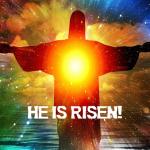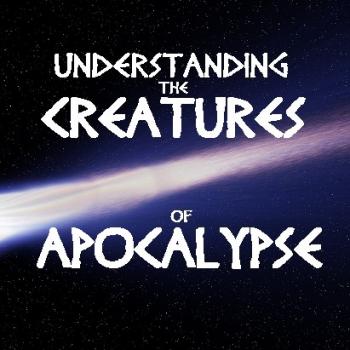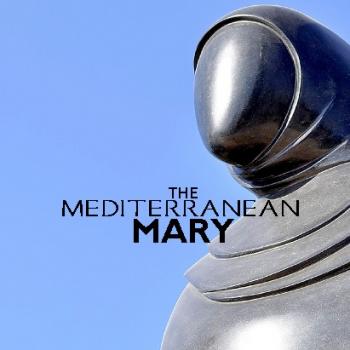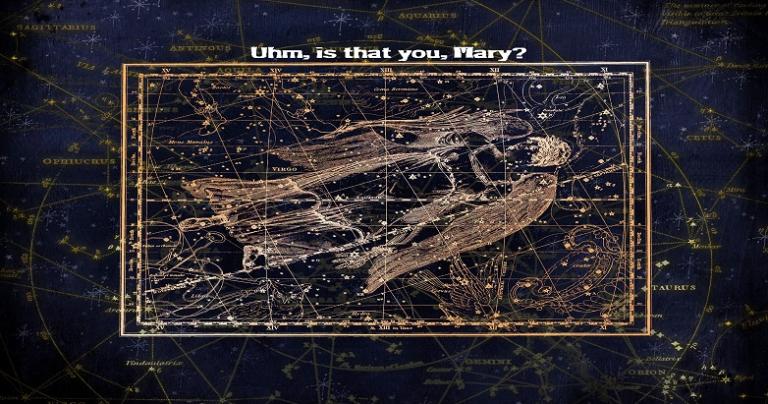
Is the Pregnant Sky Woman of Revelation 12 really Mary, the Mother of Jesus?
Pregnant and about to give birth, a woman is menaced by the Devil. He seeks to devour her child, the Lamb of God. A war rages in the sky above and on earth below between the Woman and the Serpent. What’s going on? Are we talking Marian piety here? Or Scripture? Or both?
As we have been discussing in recent May posts, the New Testament gives scant information on Mary (and little is said there explicitly about her). Beginning with the negative portrayal of Mary and Jesus’ family in “Mark,” modified only slightly through “Matthew,” these first two Gospels provide nothing as far as subsequent Mariology and Marian devotion are concerned. But things change drastically with “Luke,” and to a lesser extent, with the Gospel called “John.” The positive portrayals of the Mother of Jesus in these documents provides the material for later development concerning theology on Mary (Mariology) and her unique role in the Body of Christ and God’s saving work.
Before addressing Marian dogmas and their relationship (if any) to these two Gospels, I thought I should devote a post to the Sky Woman featured in Revelation 12. Is she Mary?
Pregnant Sky Woman Too Big to Be Human
Despite the efforts of hyper-devotionalists, Mary is 100 percent human. The Pregnant Sky Woman however, isn’t. No way is she human! Calling her “gigantic” would be an understatement. Pre-scientific, first century Israelites knew a very different cosmology than ours. But they also realized that objects in “the heavens” surrounding the earth were enormous. If the personified Moon, as they imagined it, detached from the sky vault and crashed to earth, it would dwarf mountains.
To get some perspective on how our New Testament ancestors in the faith understood the size of celestial phenomena, consider that the proportions of the New Jerusalem in Revelation 21:1—22:5. This city of astronomical size is a golden cube as tall as 260 Mt. Everests stacked onto each other and wide enough to smother half of the continental United States!
How on earth did people start conflating this Pregnant Sky Woman with the human Mary? It’s a little complicated.
Pregnant with Post-Pauline Thought
By the end of the first century, literature attributed to Paul (written either by himself or forgers) spread through the Mediterranean Jesus groups. People recontextualized, re-interpreted, and kept developing things. This continued throughout the second century and into the third. In this development we find:
- The Jesus Group (body of Christ) becomes recognized as the Bride of Christ.
- Adam is seen as a type of Christ.
- Eve is seen as a type of the Jesus Group (body of Christ).
Nobody composed the New Testament documents to eventually be collected into a library of 27 interlocking, intercontextualized, conpenetrative books of authoritative scriptures. Rather these documents evolved, written at different times, produced by different first century, early second century Jesus groups.
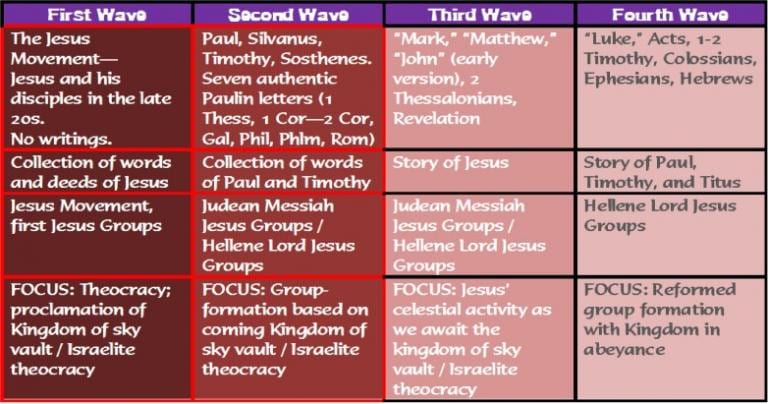
Note that in the graphic above, the focus changes as you move right, or forward through the first century.
Revelation 12 and the Pregnant Sky Woman
At some point along this process of evolution comes the Book of Revelation, from which the first lectionary reading of the Solemnity of the Assumption of Mary was taken. In its twelfth chapter, the author speaks of a sky “woman clothed with the sun, with the moon under her feet, and on her head a crown of twelve stars” (Revelation 12:1). She gives birth to a son “who is to rule all the nations” (Revelation 12:5).
Then a huge sky dragon appears (Revelation 12:3). It menaces the Sky Woman. The dragon seeking to devour the sky child (12:4). But it fails to do this because the Most High God (a henotheistic expression) brings the sky child up into the most high sky vault. Then the sky dragon pursues the sky woman. But it fails again. So the dragon goes “to make war on the rest of her children, those who keep the commandments of God and hold the testimony of Jesus” (v.12:17).
What exactly is going on here in this bizarre (to us) reading? When does this story take place? Who is the Pregnant Sky Woman? What does all this mean? One thing is certain—the Literal Sense of Revelation 12 has nothing to do with anything Marian.
Pregnant with Celestial Events and Giants
Context Group scholars Bruce Malina and John Pilch inform us that from start to finish, the entire Book of Revelation is filled with astronomical phenomena (stars, whether singular or as constellations, planets, comets, etc.). The author of Revelation, together with all ancient Mediterranean peoples, saw these phenomena as living persons.
Recall what we said about how ancient Israelites imagined concerning the size of astronomical phenomena. From that we can conclude that the Pregnant Sky Woman in Revelation 12 is colossally large. She can’t be human—she’s not Eve, she’s not Israel, and she’s not Mary. She must be a non-human sky-vault person (a goddess in a henotheistic worldview) big enough to stand on the Moon (not seen scientifically) and be clothed with the Sun (not seen scientifically).

The Pregnant Sky Woman in the Later Church
Who exactly is this Pregnant Woman? Spiritually (via an allegory-gone-wild), for centuries, some Christians have seen the Pregnant Sky Woman in Revelation as a symbol of the Church. At some point this figure began to be seen as the Church who bears Christ like his mother. With that, making a connection to Mary was a piece of cake! Concurrently with this theological symbolizing, Mary was being seen and popularly promoted as type of the Church. Because of these views, ecclesiology lent itself to Marian interpretation once Marian interest developed in the later fourth century Church.
Centuries passed, and the Church canonized the Book of Revelation. They placed it together with the Gospels of “Luke” and “John.” Now the various images of the mother-virgin, the woman at the Cross, and the woman who gave birth to the Messiah could co-mingle in the minds of Christians. These images began to reinforce each other. Finally, this got mixed together with Pauline insights about Christ and the Jesus group (now Church).
So, in a spiritual way, Mary (already morphed into the ideal Mediterranean woman) slowly became recognized as the perfect symbol of the post-Constantinian Church. Thus, in this way, the canonical Revelation text can be seen to, spiritually, talk about Mary.
Of course, as this slow evolution transformed Mary into an idealized Mediterranean Woman, and then, eventually, into Galadriel, we lost the illiterate Middle Eastern peasant girl. Everything in Christ begins with throw-away people, nothing-people, the anawim. But later on, as the Church got imperial and as allegory-went-wild, things changed. Verbal orthodoxy cloaked congenial idolatries. The result was to throw out the throw-away people like Galilean peasants. So a stand-in Mediterranean goddess replaced nothing-person Mary. Eventually, a quasi-Norse goddess replaced the Mediterranean replacement.
Allowing John to Speak
Dare we ask: What was John in Patmos, the first century Israelite astral prophet, really communicating by reporting his ASC sky journeys and visions?
Not excluding subsequent allegorical interpretations, of course (heaven forbid!), but inquiring into the Literal Sense of this passage is beneficial. The literal sense of Scripture is what a verse meant originally. Therefore we must ask: what did John the Seer, the human author, really want to convey to his original audience?
Many Catholic Christians answer fast: “It is clearly talking about Mary! Scott Hahn says so in ‘HAIL HOLY QUEEN!’” O, great Scott! Sorry, but any claim that John wished to convey a Mariology or devotion to Mary is grossly anachronistic. Recall that such developments would not exist for hundreds of years hence! All theology, Mariology included, evolves.
So long as we don’t lose the illiterate, starving Galilean peasant woman (too late?), it is good that, guided by the Holy Spirit, the Church slowly developed an appreciation for Mary. After all, she is our sister made our mother (spiritually in a wink to “John,” fellow beloved disciples). The Church celebrates this by spiritually reading Revelation 12 at Mass of the Solemnity of the Assumption and in many other good ways.
Pregnant with Popular Ideas
But that is no sanction to oversimplify things. Or to make nonsensical claims that anyone can open up a Bible and easily see the typological parallels Catholic devotionalists do sitting on 2,000 years of evolution! Please realize these great changes took place over vast periods of time. The Scriptures are not a “connect-the-dots” to all Catholic beliefs, devotions, and practices! Sorry, Scott Hahn and followers!
Enter: Real Scholarship
According to Context Group scholars Bruce Malina and John Pilch, Revelation is an edited collection of visions by the astral prophet John (Revelation 1:4, 9). He experienced these and wrote about them at different times in his life. These were later put together by another person, an anonymous Compiler (Revelation 1:1-3).
Originally, the section of Revelation 12—16 was one set of visions. It deals with the way the Cosmos was before the Flood (Genesis 1—6), and why the present deceitful condition (of John’s day) existed in urban centers throughout late first century Asia Minor.
Two periods from long ago John learned about in trance. He records this in what would become Revelation 12—16. The first period (Revelation 12) transpires just before the completion of creation during the week of Genesis 1. Then the second (Revelation 13—16) covers the period from creation until the Flood (Genesis 2—6).
Pregnant Sky Woman at the Beginning of Time
How did the Context Scholars conclude this? Note that the Pregnant Sky Woman gives birth even before the ancient Dragon-Serpent (constellation of Scorpio-Libra) is thrown to the earth (Revelation 12:1-2, 8-9). Therefore, in the understanding of first century Israelites who conflated Satan, the Devil, and the Genesis snake into one being, this all happened before the creation of humankind. The whole drama takes place in the sky vaults (12:5).
Pilch and Malina explain that this great Sky Dragon, the ancient Serpent, identified with the Devil and Satan (12:9), is still in the sky vault when it tries to eat the Sky Child (12:4). Afterward, Michael (the constellation Orion) expells the Serpent and his retinue from the sky vault. It arrives on earth, awaiting the creation of the first human beings.
John can make those connections because, as a first century Israelite, he learned Genesis 3:1-24 in a recontextualized manner where Devil, Satan, and Genesis snake are identical. And given that the serpent is already in the Garden of Eden in Genesis 3, it must have been cast out from the sky vault earlier than God’s creation of the first humans.
Sky Child of the Pregnant Woman
The Sky Child (Revelation 12:5) is the Cosmic Ram of God (12:11; see also Revelation 5:6). John mentions a Cosmic Lamb slain before the foundation of the world (13:8). So John imagines that before the completion of creation and humankind, a cosmic Lamb came into existence.
What is this Lamb John sees? This is the constellation we call Aries. It’s neck is broken, the head being turned backwards 180 degrees, standing but appearing slain (Revelation 5:6).
What an unorthodox origin John gives to Jesus! Readers should understand that John wrote down his visions long before the Christological debates of Nicaea (325) and Chalcedon (451). Different Jesus groups imagined different cosmic origins for messiah Jesus as they grappled to understand him. See how Scott Hahn’s connect-the-dots method is bankrupt?
Naughty Angels & the Flood
Consider how the entourage of the Cosmic Lamb “have not defiled themselves with women” (Revelation 14:4). According to Pilch and Malina, this recalls the angelic “sons of God” who went into the daughters of men in Genesis 6:1-4. Both good and bad angels here are identical with various stars and constellations. How do you explain tall people born to short parents in antiquity? Giant sky beings must have fathered them. They didn’t have our understandings of human biology or procreation, folks.
See how “the great city” gets split into three parts (Revelation 16:19)? Pilch and Malina claim this refers to the division of the habitable earth (Europe, Asia, and Africa). This arrangement had to already exist before the Flood (at least in the minds of ancient Israelites) because the genealogies of Noah’s three sons mentions various peoples in specific locations (Genesis 10).
Why does it say that “every island fled away, and no mountains were to be found” (Revelation 16:20)? Pilch and Malina explain that this describes the Flood. In it, “the waters prevailed so mightily upon the earth that all the high mountains under the whole sky vault were covered” (Genesis 7:19).
Mary or Virgo?
So returning to the Sky Woman, who is she in the literal sense of Revelation 12? Despite Spiritual allegory-gone-wild in the later Church, two facts eliminate the possibility that she is Eve, Israel, Church, or Mary. The first is because this Sky Woman preexists humankind as Revelation 12 takes place before humans were created. Second, her colossal size (Sun as clothing, Moon as her footstool, crowned by stars) likewise demonstrates she can’t be human. The astronomical phenomena decorating her indicates she is a zodiacal constellation on the ecliptic in the southern sky.
Adding all this up, the Pregnant Sky Woman in the Literal Sense of Revelation 12 is the constellation we call Virgo, the only female member of the zodiac.
Next time, we will explore how through a trajectory of development, Catholics go from “Luke” to the dogmas of the Immaculate Conception and the Assumption of Mary.


